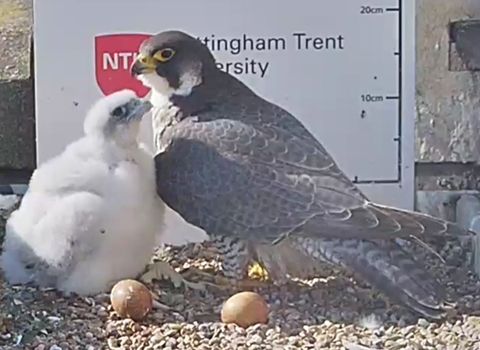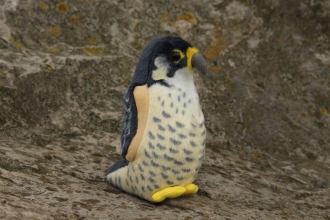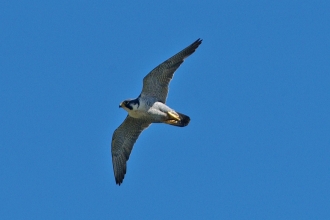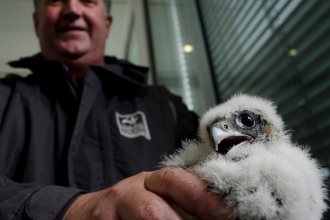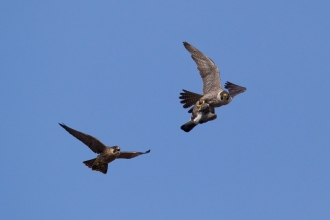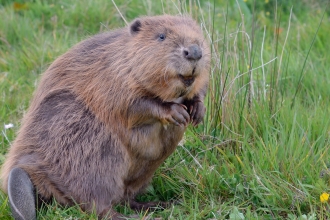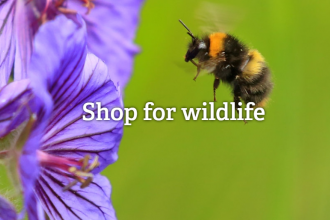Nottingham Trent University's (NTU) Newton building is home to a pair of peregrine falcons who use a nest box provided in partnership with Nottinghamshire Wildlife Trust. These webcams stream the pair's activities live for excited viewers to follow the breeding season online from laying to fledging.
WARNING: These webcams show live footage of wild peregrine falcons. Please understand that at times this may include images that you might find disturbing.
2025 Diary
8th September 2025
Cameras are down due to routine building maintenance this week.
1st July 2025
The juveniles are still around the building. Seen keeping to the shade in the heat!
6th June 2025
The chicks are more mobile now so may disappear out of camera view! The NTU team will keep track and move the cameras when they can to keep up!
29th May 2025
There is movement on the ledge now. The runway is open for practise flying and stretching of wings by the chicks. You can see their feathers coming through well now.
22nd May 2025
It's a boy and a girl!
Delighted to announce this today after successful ringing of both chicks.
15th May 2025
Sadly with two eggs unhatched it is likely these are now unviable. But we hope for two healthy strong chicks to fledge after ringing!
2nd May 2025
Say hello to two baby peregrines! One hatched on Wednesday 30th and the other on Thursday 1st.
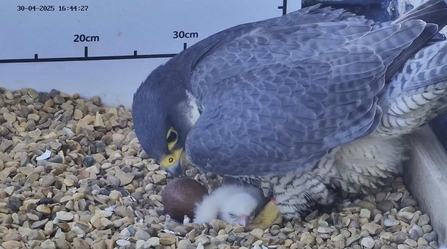
30th March 2025
A fourth egg has been laid!
27th March 2025
A third egg was laid on Thursday evening!
25th March 2025
A second egg arrived this morning!
23rd March 2025
The first egg has arrived at around 2am! Here's a video of the occasion, including a visit from Archie beforehand.
Peregrine Cam - First Egg Laid 2025 (https://www.youtube.com/watch?v=x_XZw_E_Mgw)
First egg laid on 23rd March 2025, egg can be first seen around 2:40
February 2025
Mating has been witnessed this month so here's hopeful of eggs! Keep watching throughout March and let's see who can spot the first egg being laid!
28th January 2025
Another year another successful breeding season to come? Let's hope so!
Bonding has been seen this month already within the nest.
2024 Diary
November 2024
Please do not worry, Nottingham Trent University are doing maintenance work so the cameras are turned off during this period.
20th June 2024
Despite a worrying disappearance earlier this week, the peregrine chick has fledged and is doing well! Although she remains around the roof of the Newton building for the time being, she will be seen less often on camera now she is up and about. If you'd like to follow the progress of our latest young peregrine more closely, consider signing up for the NTU Falcon Cam Facebook group where enthusiastic watchers both through the camera and from the ground report on her progress on a regular basis.
5th June 2024
After the successful ringing of the chick, we're now at a stage when it's getting ready to fledge and being more mobile so less likely to be in view of the cameras.
The good news is, this site provides lots of runways for stretching of wings as well as ledges to hide out on.
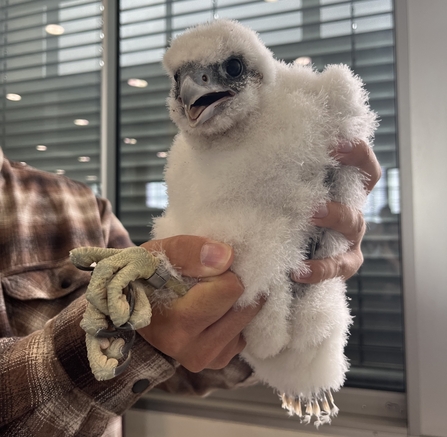
Cr. Jemma Maguire
24th May 2024
We’re delighted to announce the chick has been rung today and we can confirm it is a female.
4th May 2024
At 4.33am we saw the first chick on screen.
First screen appearance of 2024 peregrine chick (https://youtu.be/TySSvzYgepM)
Credit: Nottingham Trent University
3rd April 2024
P9 has been extremely busy over the Easter weekend as there are now four eggs in the nest!
26th March 2024
The witnessed mating this month has resulted in the first egg of the season being laid! Keep watching to see if there will be more!
January 2024
We're ready for the new season with a refreshed nest box!
Let's see what this year brings! More highs than lows we hope! But always a rollercoaster and a privilege to watch so close up.
2023 Diary
5th June 2023
Plenty of activity and movement exploring their surroundings...not easy to keep up with them on camera!
1st June 2023
The feathers are appearing through the chick fluff (Not a technical term!) and wing flapping is occurring with exploration onto the ledge alongside the nest. The ledge may well turn into their practise runway very soon so keep watching.
25th May 2023
10:30 am - Delighted to announce there are two females and a male chick!
9am - The cameras will be switched off today so the chicks can be rung. Hopefully by the end of the day we will know how many males and females there are.
12th May 2023
We have three healthy looking chicks to view on the cameras now. After such a long time it is pretty certain that the fourth egg is unviable.
6th May 2023
The third chick has hatched.
Will the fourth egg be viable too?
5th May 2023
The first chick has a new sibling! Two hatched...two eggs to go.
The second peregrine chick hatching 2023 (https://youtu.be/w-2ibzmRxRk)
The second peregrine chick hatching May 5th 2023.
4th May 2023
The first chick has hatched! But keep watching for updates and developments.
First chick reveal 2023 (https://youtu.be/bD3y6ctdG50)
First chick reveal 2023
1st May 2023
If the eggs are viable, and we are hopeful, then chicks should be hatching any day now.
2nd April 2023
A fourth egg was laid at 4:25pm. The male peregrine came to visit the new egg at 7:04pm in the evening.
4th Peregrine egg laid 2nd April 4:25pm (https://youtu.be/KRr8Av-O_J0)
4th Peregrine egg laid 2nd April 4:25pm
Male peregrine visits fourth egg laid 2nd April (https://youtu.be/nXdUNl8NC7s)
Male peregrine visits fourth egg laid 2nd April
31st March 2023
Rain has not stopped play!
The third egg was laid at 7:18am this morning.
Peregrine 3rd egg 31st March 2023 7:18am (https://youtu.be/ZUd8QM_u_b0)
The third egg of the season was laid 31st March 2023 at 7:18am
29th March 2023
At 3:08am the second egg was laid.
Second peregrine egg is laid 2023 (https://youtu.be/7g-zHIOZLh4)
Second peregrine falcon egg is laid in Nottingham city centre 3:08am 29th March 2023
First peregrine falcon egg laid 2023 (https://youtu.be/UgzK9JyXXXs)
First egg is laid 7:34pm 26th March 2023
26th March 2023
Delighted to announce the female has laid her first egg of the season! 7:34pm.
Keep watching as it is possible for up to 4 eggs to be laid over a few days before incubation starts.
22nd March 2023
Although in previous years we have seen eggs laid by now, we are still hopeful that we will have some this year. Keep watching!
February 2023
Mating has been witnessed via the web cam on a number of occasions now.
Let's hope for a successful breeding season!
2022 Diary
18th June: The chicks are using their wings! They're practicing flying at the moment but will stay around the nest site a little while longer with some support from their parents. If you're lucky you might still spot them on the camera feed.
6th June: The chicks aren't always in view of the cameras at the moment - they're often exploring the ledge. We are receiving a high number of queries about this and will post an update in this diary section when they have fledged. In the meantime, keep an eye out for them.
We are also having reports of some sound issues on the feed. No maintenance on the cameras will be done whilst the chicks are still around the nest in order to minimise disturbance.
30th May: You may notice that the chicks are getting much more adventurous and are starting to explore the ledge. We tend to get a lot of queries this time of year when the chicks are out of sight. They will often wander behind the cameras or close to the edge. Please don't panic, it is very unlikely that they will have fallen off the ledge and this exploration is an important part of their development to prepare them for fledging.
26th May: We're happy to share some footage from the ringing of this year's chicks.
Fitting the rings is an important aspect of monitoring and protecting birds of prey and is carried out by licensed ringers. It’s just one of the ways we’re working towards nature’s recovery and we know from how popular the web cam is that people care passionately about wild creatures such as peregrines. The Government is currently consulting on targets for nature’s recovery by 2042 which we feel would mean that there’s less nature in 20 years time that there is today and we’re sure you’ll agree that nature deserves better!
24th May, 4:30pm: The chicks, one female and one male, had their ID rings successfully fitted this afternoon. They are both in a good condition and well fed. The camera feed has been turned on again.
24th May: The cameras will be turned off for a while today whilst the chicks are ringed. We'll post an update once this has happened. Please don't be alarmed if it seems like the cameras aren't working.
20th May: Unfortunately it is extremely unlikely that the final two eggs will hatch, however the two chicks are growing fast and seem very healthy. A successful season remains on track.
4th May: A small hole appeared in one of the eggs this morning. By 4pm the second chick fully hatched.
3rd May: The first chick has hatched! At around 7am we got the first sightings of a chick. Hopefully it's siblings won't be far behind.
The first peregrine chick of 2022 has hatched (https://youtu.be/hfwwvsqIc6c)
The male peregrine leaving the nest, for the female to take over brooding.
11th April: Camera 1 isn't working properly. We're working with NTU on a solution. In the meantime, keep enjoying the view on camera 2!
31st March, 3:12pm: Despite flurries of snow throughout the day, egg number four was laid this afternoon.
29th March, 6:09am: Egg number three is here! Will this be the last? We'll have to wait and see.
26th March, 10:44pm: We have a second egg! If more are to be laid they usually arrive every couple of days and with a potential of up to 4 eggs, it is worth watching for more.
24th March, 5:16pm: The first egg has been laid! Peregrine's usually lay between 3-4 eggs and incubation won't start until all eggs have been laid. This is to try and ensure that chicks hatch at a similar time and are closer in size. Bigger chicks could outcompete their smaller siblings for food.
March 2022: The adult peregrines are in Nottingham all year round. Outside the breeding season, they don't spend as much time in front of our cameras but they are never far away. As the breeding season draws closer, they will spend more time at the nest so you're more likely to spot them on the live feed. Hopefully we should expect some eggs soon...
2021 Diary
Post Moretum Results: As we suspected, the bird thought to be Mrs P due to her distinctive beak (no ring), died due to a collision. Thankfully there was no evidence of poisoning. However, sadly it looked like she’d more eggs to lay.
26th November: A woodcock has been spotted in the nest area this morning. From the lack of movement from the bird, it appears to be injured or exhausted. Viewing the webcam may be distressing. We will share any updates, but at the moment we have no plans to intervene and cause disturbance to the nesting site.
We have had a number of concerns that the bird may have avian flu. We are aware of and monitoring the situation regarding avian flu in the county. It is unlikely that the woodcock has come into contact with domestic birds and so the risk of avian flu in this particular animal will likely be low. Government advice currently relates specifically to dead swans, geese, ducks, and other species including gulls and birds of prey. We are monitoring the situation and will in due course report to DEFRA if necessary.
18th June: The chick looks like a chick no more and has almost lost all of his fluff amongst his beautiful feathers. Most often out of camera sight, he is still about moving from ledge to ledge on the building. He will soon be off to find his own territory but it is expected that the parents will remain in the area all year as in previous years.
27th May: We can announce that the chick is a healthy boy!
The chick had its ring fitted today so you may have seen that the cameras were turned off for a short period whilst this happened. The chick and its ring number will be logged with BTO for future reference and sightings. To keep disturbance of the nest and any intervention to a minimum it was decided to leave the remaining eggs and clear the nest at the end of the breeding season.
5th May: The first chick has hatched!
30th April: We are actively trying to establish a cause of death of what we’re pretty sure was Mrs P. Because she had no identification ring we can never be 100% certain, but the circumstances are pretty clear cut. Mrs P was missing, the dead bird appeared to have her distinctive extra-long upper beak, and a new female has taken her place. There may have been some sort of squabble or physical interaction, perhaps leading Mrs P to crash into a building whilst trying to avoid an attack. Alternatively, Mrs P, who was relatively old for a wild peregrine, may have succumbed to exhaustion due to being harried by the new comer and being kept from feeding or resting.
As our involvement with this nest site is to ensure that these protected birds are properly monitored, we have arranged x-rays of the dead peregrine to check for evidence of poisoning and we’re awaiting the results of a detailed post-mortem. We will publish what information and updates we can in the weeks ahead but for now we have no reason to suspect foul play – so perhaps we should reflect on the fact that there are likely to be peregrines carrying her DNA raising chicks of the their own across the UK.
To give an insight into the work that goes on behind the scenes we’re also hosting a special free online webinar on the evening of Thursday May 20th which can be booked online here.
20th April: The top webcam feed now has sound thanks to the team at NTU. Listen out for the pair calling to each other, especially when they are swapping over incubation.
7th April: A second egg has been spotted in the nest laid by the new female (P9). That makes four eggs in total, two by the previous female and two by the new female.
5th April: At 00:19 the first egg was laid by the new female peregrine, The first two eggs still remain in the nest.
25th March: After a little more digging we’ve discovered more detail about the new female falcon on the scene. She would appear to be Archie’s niece and hatched in 2019. They were both from the nest of a pair known as the ‘Parliament Pair’ and assuming there has been no change in adult birds at their nest, her mother is Archie's sister which hatched in 2010 - with Archie following in 2012.
From time to time raptors, including peregrines, do mate with birds they are related to but many pairs are not entirely faithful and have additional pair matings. This means that a clutch of eggs may be fertilised by several males so even when a pair are related it is unlikely that all the chicks will carry the male bird’s genes.
With the new female being so young this is almost certainly the first time she has attempted to pair up and breed. Whilst she is inexperienced it is hoped that she will lay at least one egg and with Archie’s help, she may have a successful first season.
Thanks to the author of 'Urban Peregrines' Ed Drewitt and Nathalie Mahieu, Peregrine Monitor for peregrines at Charing Cross Hospital for this information.
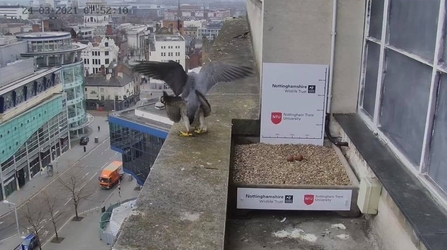
Thanks to Julie Thompson for capturing this image
24th March: Mating between the new female (believed to be from a nest site in Charing Cross, the same nest site where the male is thought to have originated from) and the resident male was seen taking place just before 8am. As it is still early in the nesting season there is a chance there still may be chicks in the NTU nest this year. The male (Archie) is still regularly spending time incubating the two eggs already in the nest, however, we would expect the new female may remove these eggs from the nest if/when she lays her own.
22nd March: Initial observations and lack of subsequent sightings suggest that the dead peregrine is indeed the female from the NTU nest (Mrs P). Nottinghamshire Wildlife Trust are working to establish a cause of death. Mrs P is a long-serving female at this nest and has been very successful at raising chicks over the years and will be missed by many fans. A new female peregrine has been spotted at the nest site bowing with the resident male (Archie). This courtship behaviour suggests a new pairing may be formed soon.
20th March: Last sightings of the female (Mrs P) followed by reports of a dead peregrine found in the City Centre (Lace Market area).
17th March: Second egg laid in the morning.
15th March: First egg laid around midnight.
January: Both cameras back online and maintenance of the scrape carried out. There are still problems synchronising the sound which are being investigated by NTU.
2020 Diary
15th June: First recorded glimpse of the chick in flight. Our 2020 chick has successfully fledged! Read the FAQs below to learn more about fledging and what happens next.
11th June: Chick has made its way to the lower ledge of the Newton building our of view of the cameras. The chick hasn't fully fledged and is still being fed by its parents.
Early June: Chick is rapidly shedding down feathers and is spending more time exploring the ledge.
6th May: First chick hatches at 2pm
5th April: Third egg laid at around 12.30am
2nd April: Second egg laid at around 2.30pm
16th March: First egg laid just after 6pm
FAQs
We get a lot of enquiries regarding our peregrine falcons as soon as the breeding season starts in March. If you have any queries please read through our frequently asked questions and hopefully we will have already answered them!
The webcam is not playing, what should I do?
We receive a high volume of queries about the webcams and are not able to assist with IT set ups on an individual basis. If you are having difficulties viewing the webcam please try the following advice:
- If all you can see are two black squares, please click or tap on one of them. It may take a second or two to load but then the live stream should start playing.
- If you find that the webcam has frozen please try refreshing the page first and check your internet connection, it is unlikely that a frozen feed will be due to any problems with the camera. If this still doesn't help, try closing down other windows/applications and view the webcam's one at a time. It may be that your device or internet connection is struggling to multitask!
- If you are still having trouble viewing the livestream please try using a different browser. There can be problems watching the webcam when using Internet Explorer, we would recommend using a different browser such as Google Chrome or Firefox if you are having difficulties loading the webcam. Search online to learn how to install these browsers on your particular device.
If there appears to be something wrong with the webcam please contact communications@nottswt.co.uk and we will let Nottingham Trent University know.
Why do they choose to nest here?
Peregrine falcons are wild birds; they choose their own nesting sites. They chose to nest on the ledge of the Newton building and were first discovered when the University was investigating building work. Later, when the university carried out the refurbishment, they provided the nestbox to allow the peregrines to continue to breed undisturbed – and to ensure the university and their contractors did not break the law. It is an offence to intentionally or recklessly disturb an active nest.
Here in Nottingham, the peregrines’ presence will have a minimal impact upon local breeding bird populations as peregrines have large territories and travel over a large area to hunt. The birds will foraging well away from the town centre. Some of the species preyed upon are migrant Scandinavian breeding birds caught as they fly north along the River Trent.
How can I tell whether a peregrine falcon is male or female?
The female has an orange ring on her left leg. Another good way way to tell the male and female apart is their size. The adult female is considerably larger than the adult male – up to a third bigger overall. As well as being smaller, male birds also tend to have a more slender look. Females can often have bolder, more striking markings. The best way to learn how to tell them apart is to look out for times when they are both on the nest and look for differences in their markings that you can recognise.
The eggs aren't being incubated, are they alright?
Incubation doesn't really begin until all the eggs are laid. This is to try and ensure that all chicks hatch at a similar time, reducing the differences in size and chances of them outcompeting each other for food. Once the last egg is laid both parents share the incubation.
How many eggs are usually laid per year?
Peregrine falcon's usually lay between 3-4 eggs each year.
How long before the eggs hatch?
Incubation starts once the last egg is laid and lasts for around 29-32 days. Both the male and female share the incubation.
Will any unhatched eggs be removed and checked or are they left?
We tend not to remove unhatched eggs until we clear the nest at the end of the season or ahead of the new breeding season. We're not currently set up to do any DNA testing on the eggs so there is no reason to remove them.
I can sometimes see wooden planks visible at the bottom of the nest, could this damage the eggs or cause a falcon to get caught?
The nest box is designed to allow drainage and prevent the nest becoming one big puddle! When the adults dig around in the nest (or scrape) the wood at the bottom of the nest can sometimes become visible. Please don't worry, the nest box currently installed has produced many successful broods.
Peregrines nesting in urban areas, on buildings, is becoming increasingly common. However, the traditional peregrine falcon nest site is usually on rocky cliff ledges. Unlike other birds of prey such as ospreys, peregrines do not bring in material to build a nest to protect the eggs.
I can't see the chicks on the camera, are they alright?
Please try not to worry if you can't see the chicks on the camera. We have a lot of concerns after around the 4 week mark that viewers can't see the chicks on the camera and that they may have fallen off the ledge. It is around this time that the chicks are big enough to start exploring the ledge despite not being ready to fledge. They often wander out of view of the cameras so please don't panic.
How old are the chicks when they fledge?
The chicks usually fledge 35-42 days after hatching, it will then be another few months until they are independent of their parents.
How will the fledged chicks learn to hunt, and when will they leave the parents?
Peregrines will withhold food items and encourage them to take longer flights. At this time, the adults will drop prey in mid-air for them to catch in a food pass – this activity contributes to bringing about the day when they will become independent. The loosening of ties with the parents is gradual and spread over several weeks, during which time they gradually learn to fend for themselves. The adults will continue to feed them until they disperse naturally. There is no evidence that the adults drive juveniles away – it is likely that they will detach themselves from the parents as instinct dictates.
Will the fledged chick return to the site? How far away from the birth site do they usually fly?
Once they have mastered the art of flying, they will probably still be dependent on their parents for food for a little while longer. We think they'll stay within a 60-mile radius.
There often seems to be one chick who doesn't get fed adequately. Why is this, and can you help?
It is likely that this will be the chick that hatched last, and because of this it will be a couple of days behind its siblings. If the conditions are difficult the parents will focus their efforts on the largest, healthiest chicks most likely to survive. We are not able to interfere as peregrine falcons are protected under the Wildlife and Countryside act and disturbing them is a criminal offence. Read more about this here.
Although to us some aspects of raising a peregrine family may seem cruel it is important to remember that these are wild birds and they are simply acting naturally.
Why are the chicks ringed and how are they ringed?
The ringing team waits until the parents are away from the nest and the whole operation is carried out as quickly as possible, often in under ten minutes, this is to minimise any disturbance or stress to the chicks. They are usually ringed around 3 weeks old. We wait until the adults are away from the ledge before accessing the nest but they are often in the vicinity and make it clear that they are not happy by flying overhead and calling. We therefore do the ringing as quickly as posisble to minimise disturbance and distress. Ringing is part of a scientific monitoring programme and it is very unlikely that a carefully executed ringing operation would cause any risk of the parents abandoning the nest. We would encourage you to watch the video made with NTU about the ringing of the 2012 chicks.
Why can't we watch the peregrine chicks getting ringed?
Once a year Nottinghamshire Wildlife Trust visit the nest to attach identification rings on the legs of the chicks. The cameras are turned off by Nottingham Trent University as the birds are protected and in the past people have worried that the chicks are being stolen and have mistakenly called the police. The ringer also obscures the view of the camera as they have to stand in front of it to reach the chicks. We try to take better video and photographs during the ringing process rather than live-stream it.
If you can visit the nest for the ringing process, then why can't you intervene if the chicks are struggling?
The decision about whether to intervene when the chicks were struggling is a much wider issue. It is possible that during a difficult period any further stress could lead to the adults abandoning the nest completely. Most importantly, we will not intervene as they are wild birds, and if we removed them from the nest it would be almost impossible to return them to the wild.
If a chick dies, why can't you remove it from the nest?
If we remove chicks from the nest in this way we would almost certainly be guilty of an offence under the terms of the Wildlife and Countryside Act, due to the risk of disturbance. Once a problem has been observed, the female will very rarely leave the nest – sitting tight and doing her best to keep the chicks warm. Therefore, if we access the nest at a time when the adult birds are under severe stress, we would risk the parents deserting the nest site.
In terms of the design and location of the nest itself, it has been successful over many years, raising numerous clutches. While we can see both sides of the argument regarding intervening, we feel that as they are wild birds we should let nature take its course. The cameras were initially installed for security, to prevent the nest being attacked. We now have the added privilege of being able to share the ability to observe the family with the general public – even if the viewing can become difficult at times.
If a chick does die and you are not able to intervene, what happens to it?
It is most likely that the mother will at some point move them out of the nest, but there is also a possibility that she may eat them, and feed them to the surviving chicks.
When and how often is data about ringed falcons recovered?
Whereas small birds are often trapped as part of monitoring operations, providing good levels of data about movements, age ranges and populations etc, peregrines are not routinely trapped as there is no safe way to catch them other than in an emergency situation. Therefore, data about ringed chicks is quite rare as it is only gathered when a chick is found dead or injured - or when they occupy a nest with cameras suitable to give a good view of the ring.
Do you keep any records of the pigeon rings discarded in or around the nest?
Yes. Once the falcons have left for the year, the team from NTU clear the nest and any rings found are passed on to Notts Wildlife Trust. They are then logged with the Royal Pigeon Racing Association. You may find this NTU falcons blog entry of interest.
Why doesn't the nest have a roof for shelter?
A nest box with a roof was trialled many years ago, but the falcons chose to ignore it. Very early on when they first arrived they laid their eggs in the gutter, and consequently these were washed away. This is why we installed the tray-style box we have today.
Do peregrines eat their own eggshells?
While eating the shells would make good sense, both in terms of preventing the white interiors of the eggs giving away the location of the nest to predators and as a means of recovering minerals lost in the egg making process, there is nothing to suggest that all female peregrines do this. One expert, Derek Ratcliffe, has suggested in his book that peregrines nibble at the shells to break them up rather than to eat them. All of this research is thanks to Derby Cathedral Peregrine Project.
What can I do to help the peregrine falcons?
Whilst peregrine numbers are stable, the birds still need protection so supporting conservation organisations such as The Wildlife Trusts is one way to help. They also need a healthy environment in which to thrive, so anything you can do in terms of making your garden more wildlife friendly will help overall.

